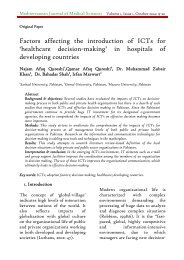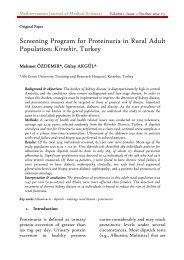Issues and Prospects of e-health in Pakistan
Background & objectives: In connection with access to information in developing countries, information flows through existing networks of communication is a main theme in the current IS literature . Methods:Information-intensive infrastructure is a requirement for information dissemination due to the shortage of network infrastructure in the majority of developing states. It is verified by many researchers that information managing technologies with their main purpose of ‘handling information’ have the advantage to enhance already existing technologies by making better information-communication a priori to new ICT innovations .Presently health information system infrastructure is deficient in resources to meet the demands and needs of increasing population in developing countries. Health care systems of developing countries have major barriers like poverty and lack of technological sophistication. Results:The basic difficulties or barriers in using information technologies include poor or inadequate infrastructure, insufficient access to the hardware and inadequate or poor resources allocation. By eliminating these barriers population health status can be improved in developing countries. Interpretation & conclusion: This study aims to determine the main issues and prospects for ehealth in the current situation of developing countries like Pakistan and the way forward for policy makers to manage all issues in future for more effective and rational decision-making in healthcare organizations. Key words: e-health; challenges; prospects; developing countries; Pakistan
Background & objectives: In connection with access to information in developing countries,
information flows through existing networks of communication is a main theme in the current
IS literature .
Methods:Information-intensive infrastructure is a requirement for information dissemination
due to the shortage of network infrastructure in the majority of developing states. It is
verified by many researchers that information managing technologies with their main purpose
of ‘handling information’ have the advantage to enhance already existing technologies by
making better information-communication a priori to new ICT innovations .Presently health
information system infrastructure is deficient in resources to meet the demands and needs of
increasing population in developing countries. Health care systems of developing countries
have major barriers like poverty and lack of technological sophistication.
Results:The basic difficulties or barriers in using information technologies include poor or
inadequate infrastructure, insufficient access to the hardware and inadequate or poor
resources allocation. By eliminating these barriers population health status can be improved in
developing countries.
Interpretation & conclusion: This study aims to determine the main issues and prospects for ehealth
in the current situation of developing countries like Pakistan and the way forward for
policy makers to manage all issues in future for more effective and rational decision-making
in healthcare organizations.
Key words: e-health; challenges; prospects; developing countries; Pakistan
You also want an ePaper? Increase the reach of your titles
YUMPU automatically turns print PDFs into web optimized ePapers that Google loves.
Mediterranean Journal <strong>of</strong> Medical Sciences V1, I1 October 2014: 31-52 34<br />
emergency situations (Ansari et<br />
al.,2012).<br />
There has been an explosion <strong>in</strong><br />
knowledge <strong>and</strong> <strong>in</strong>formation<br />
management activity, ma<strong>in</strong>ly <strong>in</strong><br />
<strong>health</strong>care sector over the<br />
previous few years. By <strong>and</strong> large,<br />
hospitals <strong>and</strong> medical schools<br />
have started us<strong>in</strong>g the services <strong>of</strong><br />
doctors who possess computer <strong>and</strong><br />
computerization skills. These<br />
organizations have also obta<strong>in</strong>ed<br />
complicated <strong>in</strong>formation systems<br />
to collect <strong>and</strong> retrieve<br />
accumulated knowledge. E<strong>health</strong><br />
system <strong>in</strong>cludes many elements<br />
such as telemedic<strong>in</strong>e, teleeducation,<br />
telematics for better<br />
management <strong>of</strong> <strong>health</strong>care <strong>and</strong><br />
research (Kijsanayot<strong>in</strong> ,<br />
Kasitipradith & Pannarunothai<br />
,2010). There are four areas where<br />
<strong>health</strong> <strong>in</strong>formatics is perform<strong>in</strong>g<br />
an escalat<strong>in</strong>g role <strong>in</strong> <strong>health</strong>care<br />
development: a) adm<strong>in</strong>istrative,<br />
b) education <strong>and</strong> tra<strong>in</strong><strong>in</strong>g, c)<br />
quality improvement <strong>and</strong> d) the<br />
recovery <strong>of</strong> efficiency <strong>of</strong> <strong>health</strong><br />
care services (Bhutto et al., 2010).<br />
In <strong>Pakistan</strong> 72% <strong>of</strong> population<br />
lives <strong>in</strong> rural areas <strong>and</strong> 28% <strong>of</strong><br />
population lives <strong>in</strong> urban areas.<br />
Condition <strong>of</strong> <strong>health</strong> can be<br />
determ<strong>in</strong>ed effortlessly from the<br />
reality that there are 74 physicians<br />
per 100,000 persons <strong>in</strong> early 2000s.<br />
There are several rural areas<br />
where people have not seen a<br />
capable <strong>and</strong> skilled <strong>health</strong><br />
pr<strong>of</strong>essional <strong>in</strong> their entire life<br />
(Bhutto et al., 2010). The<br />
municipal areas <strong>of</strong> S<strong>in</strong>dh are well<br />
equipped with <strong>health</strong> facilities;<br />
which are not enough for huge<br />
population but facilities are there,<br />
whereas rural S<strong>in</strong>dh does not have<br />
well equipped <strong>health</strong> facilities.<br />
Available possessions at urban<br />
areas can be shared as well as<br />
exp<strong>and</strong>ed to the rural areas with<br />
the help <strong>of</strong> digital connectivity.<br />
Particularly, Karachi capital city<br />
<strong>of</strong> S<strong>in</strong>dh holds very latest<br />
<strong>health</strong>care facilities (Durrani et<br />
al., 2012).<br />
In urgent cases where <strong>in</strong>stant<br />
medical treatment is very vital,<br />
current studies reveal that before<br />
time <strong>and</strong> particular pre-hospital<br />
patient management leads to the<br />
patient’s survival. Especially <strong>in</strong><br />
cases <strong>of</strong> serious head <strong>in</strong>juries,<br />
sp<strong>in</strong>al cord or <strong>in</strong>ternal organs<br />
damage <strong>and</strong> pa<strong>in</strong>, the way the<br />
events are treated <strong>and</strong> transported<br />
is critical for the forthcom<strong>in</strong>g<br />
well-be<strong>in</strong>g <strong>of</strong> the patients<br />
.Br<strong>in</strong>g<strong>in</strong>g improvements <strong>in</strong><br />
<strong>health</strong>care services <strong>and</strong> rema<strong>in</strong> fit<br />
<strong>and</strong> <strong>health</strong>y is one <strong>of</strong> the most<br />
discussed <strong>and</strong> key issues <strong>in</strong> our<br />
society. The acceptance <strong>of</strong> ITapplications<br />
<strong>in</strong> <strong>health</strong>care sector<br />
have very solid <strong>and</strong> successful<br />
attempt for the provision <strong>of</strong><br />
improved <strong>health</strong>care services<br />
(Malik et al., 2008). But constant<br />
©2014 Mediterranean Center <strong>of</strong> Medical Sciences








